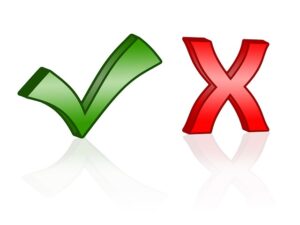Does Positive Mean What You Think It Means?
 When chatting with others, we all understand what someone means when they say positive or negative. Positive usually falls in line with the idea of the “bright side” as in being an optimist and having a positive attitude. Negative on the other hand usually refers to the idea of the “dark side” as in being a pessimist and having a negative attitude.
When chatting with others, we all understand what someone means when they say positive or negative. Positive usually falls in line with the idea of the “bright side” as in being an optimist and having a positive attitude. Negative on the other hand usually refers to the idea of the “dark side” as in being a pessimist and having a negative attitude.
Although these are examples of proper uses of these words, thinking about them this way can be confusing when trying to apply them in scientific discussions. For example, whenever I hear someone say something like, “I am a big believer in positive reinforcement,” I know that that person doesn’t know what they are talking about…
The phrase “positive reinforcement” is the example that I’m going to use to explain the meaning of positive versus negative. Reinforcement and it’s counterpart punishment refer to the concept of operant conditioning. Operant conditioning is the type of learning that occurs as the result of consequences as opposed to classical conditioning which pertains to learning through reflexes (think Pavlov’s drooling pooch). This relates to physical therapy since operant conditioning and graded exposure are treatments commonly encouraged for addressing chronic pain. As a side note, this has been shown to be moderately effective, but providing, reassurance, addressing the depression, and encouraging an internal locus of control has been shown to be more promising.
Reinforcement and punishment should be pretty easy to understand. They are both consequences in the operant conditioning model. Reinforcement is a consequence that causes a behavior to occur with more frequency (it reinforces it). Punishment on the other hand is a consequence that causes a behavior to occur with less frequency. Now, when we start talking positive and negative, we are describing the manner in which the consequence is provided.
The term “positive”, at its core, refers to the words with or add whereas “negative” refers to the words without or remove. Think of special test results that are either positive or negative. They don’t refer to good and bad rather they refer to with and without. In operant conditioning, positive refers to a consequence that involves adding something. Negative refers to a consequence that involves removing something. Now, this leaves us with four options: Positive reinforcement, positive punishment, negative reinforcement, and negative punishment. Of course, when you misunderstand the terms positive and negative, you greatly misunderstand operant conditioning.
Many people think of positive reinforcement as reinforcing good behavior and negative reinforcement as reinforcing bad behavior. This might be true in their example, but that truth is not inherent to the terms positive and negative. This misunderstanding is why the phrase “positive punishment” often makes no sense to people. Why would you punish positive behavior???
Reinforcement just means that a behavior is being encouraged. Positive reinforcement would mean that you are encouraging a behavior by adding a pleasant stimulus (“reward”). For example, giving a child a treat. Negative reinforcement refers to encouraging a behavior by withdrawing an unpleasant stimulus. Such as allowing a child to skip their chores for the evening. Either example reinforces behavior whether or not that behavior was desired.
Punishment means that a behavior is being discouraged. Positive punishment involves discouraging a behavior by adding an unpleasant stimulus. Giving additional chores for example. Negative punishment means discouraging a behavior by removing a pleasant stimulus like taking away a treat. Either way, you are discouraging a behavior. Again, it does not reflect on whether or not the behavior was desired.
Is operant conditioning through these consequences always intentional? Of course not. I would say most of the time consequences are provided unintentionally. Think of the behaviors that you would like to see your patients exhibit. Behavior related to locus of control, for example, is definitely important. Ask yourself, do you actively reinforce behavior associated with an internal locus of control? Or maybe you unintentionally reinforce behavior associated with an external locus of control? Do you punish independence and reinforce dependence?
What about pain behavior? Do you reinforce pain behavior by adding “feel-good” treatments (positive reinforcement) and/or by taking away their challenging exercises (negative reinforcement)? Do you punish a patient who reports feeling better by making that patient do exercises at the other end of the clinic in relative isolation while you give all of your attention to a more “needy” patient?
Of course I’m not advocating berating your patients who have pain and forcing them to charge through excruciating exercises! Just try to be aware of the reinforcement and punishment, positive or negative, that might be at play. You may actually be encouraging the exact factors that are keeping your patient from progressing.
